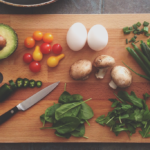Don’t be fooled by the spooky nature of the jack-o-lantern because pumpkins are one of the most nutritious fruits out there! They are full of antioxidants and disease-fighting vitamins so these gourds aren’t just for carving. What can be tricky is sorting through all of the pumpkin flavored foods, snacks, and desserts to find the best options. In this post I hope to shed a light on these foods and help you determine the healthiest choices for you and your family.
PUMPKIN-FLAVORED EVERYTHING
Over the past few years, pumpkin has taken over the shelves at restaurants and grocery stores. Beginning in September (and sometimes even earlier) you can find products like pumpkin spice lattes and flavored coffees, pumpkin spice cookies, pumpkin spice cereal and oatmeal, pumpkin beer, and even pumpkin spice flavored dog treats! The options are endless on pumpkin-flavored foods so how can you tell what is healthy, and what is not?
THE GOOD
- Pumpkin is a very calorie-friendly, nutrient dense fruit: one cup of pure canned pumpkin (pumpkin puree) has 80 calories and less than 1 gram of fat.
- Due to their bright orange color, they are very high in beta-carotene which is converted to vitamin A in the body. Vitamin A plays an important role in eye and skin health, and immune function.
- Don’t forget to save the seeds! In addition to being a good protein source, containing 7 grams per ounce, pumpkin seeds (also known as “pepitas”) are an excellent source of dietary fiber, omega-3 fatty acids, heart-healthy magnesium and potassium, and immunity-boosting zinc.
THE BAD
If a food has pumpkin in the name, it must be healthy, right? Sorry, pumpkin spice lovers, but the answer is “no.” Many pumpkin and pumpkin spice flavored products are highly processed and contain artificial ingredients, colors, and sweeteners. Seeing the word “pumpkin” on an ingredients list or on a menu doesn’t mean that food is healthy, just like seeing the words “organic,” “fat free” or “gluten-free” doesn’t always indicate a healthy product. Some pumpkin flavored foods could contain more fat and calories than an entire candy bar. The healthier alternative could be to add your own mix of pumpkin spices like cinnamon, nutmeg, and cloves and some pure pumpkin puree to foods like oatmeal, low-fat Greek yogurt, or soup.
THE UGLY
The reality is that most pumpkin spiced products don’t even contain real pumpkin or any of the pumpkin pie spices like cinnamon, clove, nutmeg, ginger. Although pumpkin is included in the name of the Special K Pumpkin Spice Crunch Cereal (Kellogg’s), pumpkin is not listed in the ingredients list. Another example is Pumpkin Spice Oreos (Nabisco). On the ingredients list, it does not list pumpkin or any of the pumpkin spices only stating “natural and artificial flavor.” Starbucks’ PSL started the pumpkin spice food craze but don’t fall under its spell by assuming that the pumpkin spice version is better for you than the original version. As I mentioned earlier, your best bet is to add your own pumpkin to some of your favorite foods. If that isn’t your thing, here is a list of the best store-bought pumpkin and pumpkin spice products you can treat yourself with during the autumn season:
- 100% pure pumpkin puree (canned)
- Raw pumpkin seeds
- Trader Joe’s Pumpkin Spice
- RxBar Pumpkin Spice
- Peanut Butter & Co Pumpkin Spice
- Blue Diamond Almonds, Pumpkin Spice
- Siggi’s Strained Low Fat Yogurt, Pumpkin and Spice
- KIND Bars, Caramel Almond Pumpkin Spice
- Purely Elizabeth Pumpkin Fig Ancient Grain Granola
- Barbara’s Bakery Pumpkin Puffins
- Halo Top Pumpkin Pie Ice Cream



